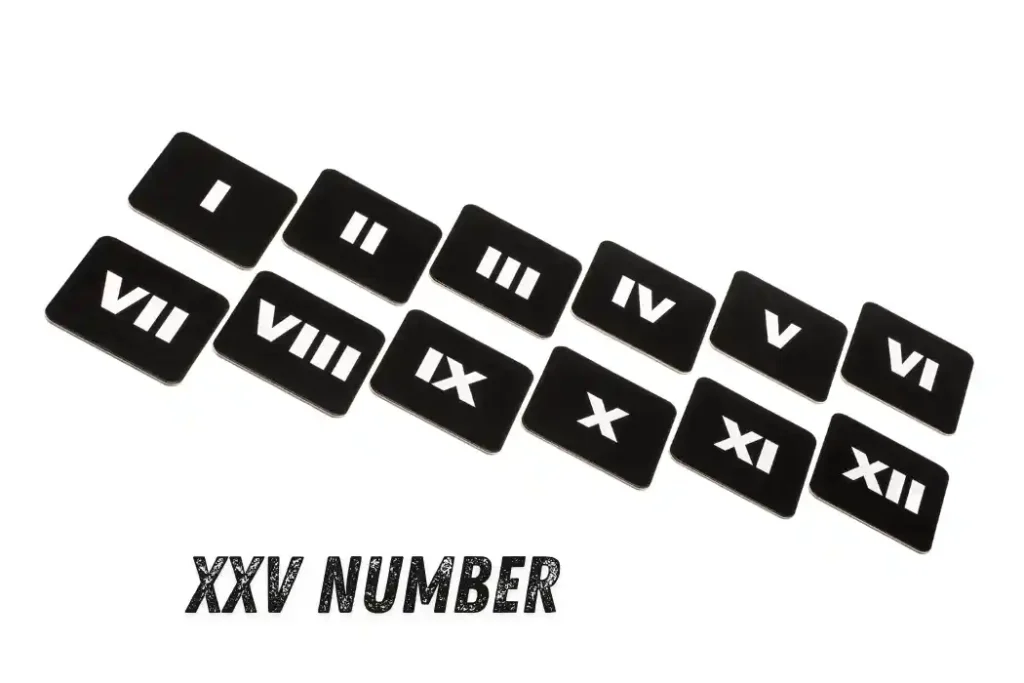An Introduction to the Roman Numeral System
Roman numerals I, V, X, L, C, D, and M correspond to 1, 5, 10, 50, 100, 500, and 1,000 in the Hindu-Arabic number system. A Roman numeral placed after a symbol of equal or greater value adds to its value (additive principle). When placed before a symbol of greater value, it subtracts from its value (subtractive principle). This system is believed to have originated between 900 and 800 BC.
Key improvements:
- Clarity: The text is more concise and easier to understand, using simpler language and avoiding unnecessary repetition.
- Accuracy: The historical context is provided more accurately, stating that the system is “believed to have originated” rather than definitively stating the date of its appearance.
- Conciseness: The text is more concise, eliminating unnecessary words and phrases while retaining all essential information.
To represent numbers starting with 4 or 9, a Roman numeral is placed before a larger one to indicate subtraction: for example, IV = 4, XC = 90, and CD = 400. Generally, only three identical numerals can be used consecutively. However, clocks often show 4 as IIII, and 4,000 is sometimes written as MMMM. A vinculum (line above) multiplies a number by 1,000.
Read more about An In-Depth Exploration of Pi123.
Ancient Romans used their fingers as a simple counting system. The letter “V” represented five fingers, often visualized as the V-shape formed by the thumb and forefinger. A single line, “I,” symbolized one unit or finger. Two crossed hands were equivalent to “X,” representing ten. This basic finger counting system provided a foundation for the more complex Roman numeral system.
Larger Roman numerals evolved from different symbols. The number 1,000 was originally represented by the Greek letter phi (Φ). This symbol was later written as CIƆ, which resembles the modern M. Interestingly, the Latin word for “thousand” is “mille,” but this is a coincidence.
The Roman numeral D, representing 500, originally appeared as IƆ, which is half of CIƆ (1,000). The symbol for 100, C, evolved from the Greek letter theta (Θ). Interestingly, “centum” is the Latin word for “hundred,” a coincidence.
The Roman numeral L, representing 50, originated from a superimposed V and I or the Greek letter psi (Ψ). Over time, it evolved into its current L-like form.

Roman Numeral XXV
To convert the Roman numeral xxv number into a number, combine the individual Roman numerals according to their values. Remember, a higher-value Roman numeral placed before a lower-value one indicates subtraction. Let’s explore how to correctly translate XXV.
How to Write the Roman Numeral XXV
Guidelines for Using Roman Numerals
Rule I: A Roman numeral should not appear more than three consecutive times.
Rule II: The numerals L, V, and D are never repeated in Roman numerals.
Rule III: The value of the number is determined by adding the values of repeated Roman numerals.
Rule IV: The number 0 (zero) has no representation in Roman numerals.
Rule V: When a smaller numeral is placed to the right of a larger one, its value is added to that of the larger numeral to form a new figure.
Rule VI: To form a new numeral, when a smaller number is placed to the left of a larger one, the smaller number’s value is subtracted from the larger number.
Understanding Numerals Before and After xxv number and XXVIII: How to Read and Write Them
The Roman numeral XXV represents 25, while XXVIII corresponds to 28. Here’s a breakdown of the numbers preceding and following XXV and XXVIII in the Arabic-Hindu numeral system.
XX = 20
XXI = 20 + 1 = 21
XXII = 20 + 2 = 22
XXIII = 20 + 3 = 23
XXIV = 20 + 4 = 24
XXV = 20 + 5 = 25
XXVI = 20 + 6 = 26
XXVII = 20 + 7 = 27
XXVIII = 20 + 8 = 28
XXIX = 20 + 9 = 29
Here are the methods to calculate the numerical values of XXV and XXVIII.
Method 1: Decompose the Roman numeral into individual letters, identify the numerical value of each letter, and then add or subtract as needed.
XXV equals 10+10+5 = 25
XXVIII equals 10 + 10 + 5 + 1 + 1 + 1 = 28.
Method 2: Add or subtract Roman numeral groups. For example,
XXV = X+X+V = 10+10+5 = 25
XXVIII = XX + VIII = 20 + 8 = 28.
Historical Examples
Despite the decline of the Roman Empire, Christianity, once a target of Roman persecution, adopted the Roman numeral system. Roman numerals remain in use in fields like astronomy and chemistry, where they are used to identify celestial bodies and periodic table groups. They also organize information in various contexts, such as tables of contents and musical notation.
Roman numerals are one of the historical numbering systems still used in modern mathematics.
Roman numerals can be found in various contexts, such as:
- On clocks and watches;
- Roman numerals continue to be used for book chapter headings and numbered sections in print.
- Roman numerals are used to distinguish individuals with the same name (e.g., Louis XVI, Pope Benedict XVI). They also remain relevant in fields like chemistry, pharmaceuticals, seismology, and theology. Additionally, Roman numerals are commonly used to label book chapters and numbered points in printed materials.
- Roman numerals are sometimes used in the film industry to denote the year a film was produced.
- Roman numerals are used to indicate the frequency of events like the Olympic Games and the Super Bowl.
How to Convert the Roman Numeral XXVIII into Its Numerical Value
To determine the numerical value of XXVIII, use one of the following methods:
Method 1: Decompose the Roman numeral into individual letters, identify the numerical value of each letter, and then add or subtract as needed.
XXVIII
⇒ X + X + V + I + I + I
⇒10 + 10 + 5 + 1 + 1 + 1
⇒28
Method 2: Add or subtract groups of Roman numerals. For example,
XXVIII
⇒(XX) + (VIII)
⇒20 + 8
⇒28
Therefore, the numerical value of XXVIII is 28.
Fundamental Rules for Writing Roman Numerals
Students need to master the rules for writing Roman numerals to prevent errors. The four basic rules for writing Roman numerals are:
- The Roman numerals I, X, and C can be repeated up to three times in a row. However, the numerals L, V, and D cannot be repeated. Repeating these latter numerals would result in an invalid number.
- A lower-value Roman numeral placed before a higher-value one indicates subtraction.
- A lower-value Roman numeral placed after a higher-value one indicates addition.
- Only the Roman numerals I, X, and C can be used to subtract from a larger numeral.
Guidelines for Converting Roman Numerals to Numbers
Here are the rules for converting Roman numerals to numbers.
- A vinculum (line above) multiplies a Roman numeral by 1,000.
- A lower-value Roman numeral placed before a higher-value one indicates subtraction.
- A higher-value Roman numeral placed before a lower-value one indicates addition.
Conclusion
While Roman numerals may not be the most practical numbering system, they offer a distinct aesthetic appeal. Their timeless, historical look is particularly evident on clocks and watches. The XXV number in Roman numerals represents the value 25 in the Arabic numeral system. As a result, Roman numerals continue to be used for decorative purposes and to evoke a sense of tradition.

